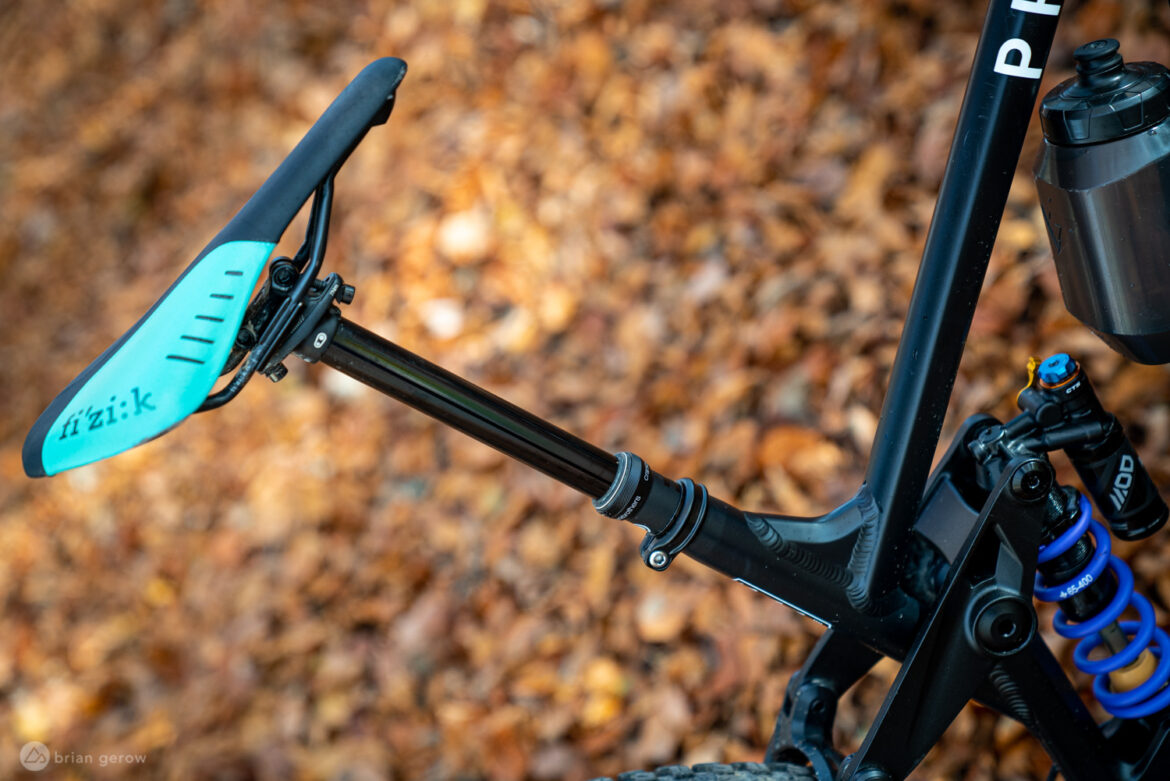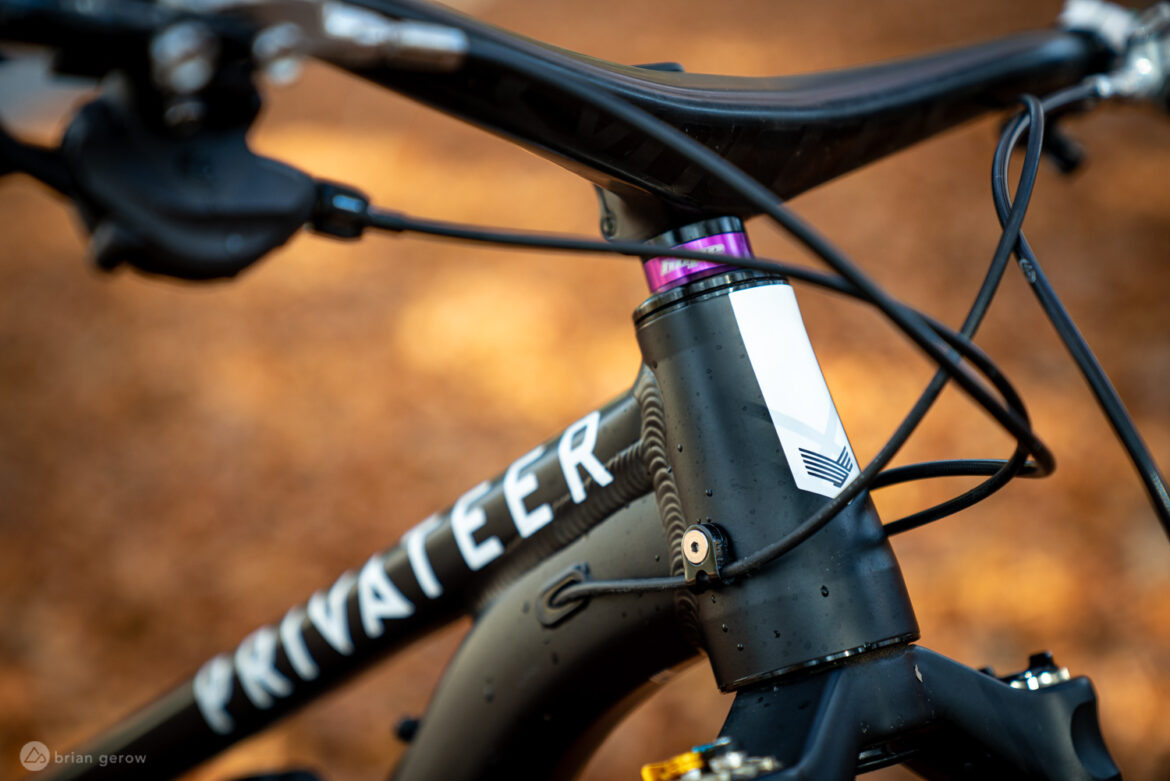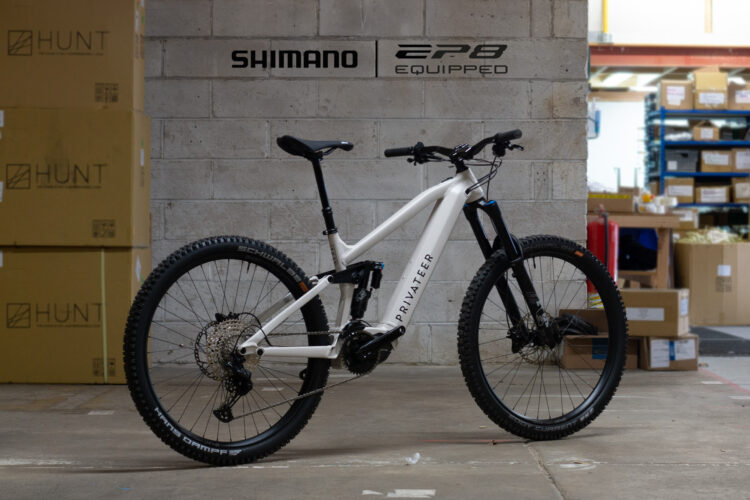
British privateer racer Matt Stuttard had some impressive results in 2020, finishing in 8th position at the Zermatt sliding match, and earning respectable 30th and 31st place results in the following two Italian rounds. Oftentimes when we get to test a bike that top Enduro World Series riders pilot, we look at how well they are doing on the bike and make some inferences about the design. With the Privateer 161, the designer is the famous one.
The team at Privateer knew what sort of bike they wanted to have, how it should handle, and roughly what price point they wanted to hit. They also knew that Alastair Beckett from Redburn Design was the right person to make it all happen. Beckett was a World Cup mechanic for a number of years before going on to design frames for Nukeproof, Privateer, and other successful brands. For more on that story, check out our podcast interview with Alastair where he describes the process of designing a fresh mountain bike frame.
In order to keep the cost of the 161 affordable, Privateer decided to use existing aluminum tubes that are used in several other frames, all welded to their own geometry and strength specs. All four sizes of the frame retail for $1,759 or €1,799, including a RockShox Super Deluxe Ultimate shock. Complete bikes sell for $3,719 + $112 shipping, or €3,979. Size 1 frames use 27.5″ wheels, while sizes 2 through 4 roll on 29″ tires, and all bikes squish 161mm of rear travel behind a 170mm fork.
While I decided to build this bike with review components, the stock spec is a fantastic deal. For under $4k, you get a 161 frame and shock, RockShox Lyrik Ultimate 170mm RC2 fork, Shimano SLX drivetrain and XT shifter to keep the double down-shifts, powerhouse Magura MT5 brakes, a Hunt Endurowide Wheelset, OneUp V2 dropper, and a set of Michelin Wild Enduro 2.4″ rubber.
Frame deets
Sturdy is a necessary adjective to describe the 161. The bike was designed to hold up throughout a full, non-pandemic, enduro season, with minimal maintenance. The chain and seatstays leave ample space for mud clearance around 2.4″ tires, so there’s no need to worry about sanding holes in the tubing during muddy races. The gap between the seat tube and chainstay bridge is tight, and a simple piece of moto-foam will keep it from getting packed with mud. There’s also no space at the base of the shock for dirt to build up and wear on the shaft. Clearly, it rains a fair bit where this bike was designed. Top all of that off with robust dime-stacked welds to hold it all together, and three large bearings at the main pivot, and we have a wonderful little tank to play with.
The 161 uses a trunnion mount shock, which saves space in the front triangle for snacks and a water bottle. In some cases, shocks are overly used as structural elements in frame designs, and the added stress can cause issues with the main seals in trunnion shocks. Privateer took care of that concern with a massive one-piece rocker link that provides all the stiffness the frame needs without dumping lateral energy into the shock. I have tested a few shocks on this frame, and the alignment between triangles is spot on. The pivot bearings feel as smooth as grease after a few months of riding, and I’m confident they will stay that way for at least a full season.
The cable and housing web on this bike is about as simple as they come. All of the cables are clamped against the frame just after exiting the handlebar, making for an exceptionally quiet little control nest that doesn’t rub or vibrate against the head tube no matter how sharply you turn the bars. From there, the dropper housing slips internal, while all of the other cables run across the top of the down tube to their eventual ends. The dropper cable pops out again before the BB to reenter the seat tube shortly after. It’s like a tube-shaped marmot, quickly hiding in neatly-placed ports. The little door that the dropper cable passes through up front keeps it tight enough that it hasn’t made a single sound over the months that I have been riding this bike. The only other internal piece of cable on the 161 is a brief chunk of the shift housing that passes through the chain stay on its way to the gear-changer doohickey. Coupled with the external BB, this bike is a breezy breeze to work on.
While the frame protection is relatively minimal, it’s undoubtedly enough for these tough alloy tubes. I have pitched countless stones at the downtube with no sign of damage, and the thin rubber silencers on the chainstay and seatstay manage to make this one of the quietest bikes I have ridden in a long while. Both rubber slabs on the rear end peeled back a little over the first few rides, but they haven’t lifted any further since and they do a fantastic job of keeping the chain quiet.
My heel has managed to rub through the paint on the right side, which happens on a lot of bikes I ride because my heels are always turned in and I descend with my right foot back more often than not. Folks buying a new 161 might want to add a piece of frame protection here or purchase the raw alloy frame with no paint to scrape off. Overall the matte black finish has held up well, and apart from this one spot, there are no major abrasions or signs of wear.
Geometry

The angles and tube lengths for the 161 are designed around throttle-open enduro racing. Period. They’re not about making a playful trail bike that you can race, or a do-it-all bike. Fast racing is the focus.
The Size 2, 29″ wheeled whip I tested has a stabilizing 470mm reach, 440mm chainstays that shift by 6mm between frame sizes, a comfortable 64° head tube angle, and a bottom bracket drop of 30mm. The seat tube is 420mm short, allowing me to mount a 170mm dropper post with a few millimeters to spare. This Crankbrothers post I’m testing has an unusually long lower tube, and thankfully the 161 eats 250mm of it.
The outlier element of this frame is its 80° seat tube angle. At the moment it’s the steepest in the industry, and it makes the bike’s long reach and slack HTA positively manageable on the way uphill. This bike is burly-built instead of weight-watching and designed in every last way to go fast downhill. The upright seat tube makes it a pleasure to pedal ascents and allows riders a wider range of fore/aft adjustment across the saddle rails. It’s the first long-travel bike I’ve ridden that didn’t beg to have the saddle slammed full-forward.
Leaf spraying fun

As stated, this big bike climbs well. I won’t belabor the point, but it is genuinely impressive for a bike this capable, this slack, and this long, at this weight. Since you’ve been asking nicely, it weighs just over 35lbs with a coil fork and shock. I have become so comfortable riding further forward while seated that all of my other bikes now have their saddles slammed to the rear-elbow in the saddle rails. It’s cozy. That forward position not only puts the rider in an ideal climbing position where we’re no longer perched on the nose of the saddle, but it also makes riding further forward feel more natural. I lost the rear end of this bike on a few early descents simply because I was hanging all of my weight over the handlebar, comfortably getting max cornering grip. After a small adjustment I remembered to better balance my pounds, and I’m enjoying how easy it is to throw the rear end around when needed.
While the rear suspension does remain super active on ascents that movement doesn’t translate to pedal bob like it sometimes can. The rocker link will bob and flow with weight shifts and terrain, but it doesn’t produce the classic seasick pedal-bob sensation we’re all trying to avoid. Climb switches on both the stock air shock and the Formula Mod that I tested on the 161 have managed to cease all rocker movement, making for an efficient road climbing platform when there isn’t a fun trail to the top.
That bob-less platform and the bike’s supportive leverage curve give it a strong sprinting character, which along with some “plow factor” is a key enduro racing element. With the air shock mounted up the rear end had a notable pop to it, and I am able to find a balance between it snapping back quickly and maintaining enough grip. The coil feels even better in the grip department, as expected, and I’ve swapped in a harder spring for fast park riding and a softer coil for laps at home. Pumping for speed feels fantastic on either shock, as the rear wheel travel ramps up in just the right spot to rebound and add forward energy.
Photos: Ulysse Daessle
Duh, it’s downhill time! Knowing that a lot of readers appreciate comparisons, I’ll begin there. The closest downhill-party parallel I can draw between the 161 and another bike is to the Specialized Enduro that I tested this summer. While the shock layouts are dastardly different, both bikes use a Horst link design that bears some ride-feel resemblance.
Like the Enduro, the 161 sits closer to the plow end of the plow-to-playful continuum, but it’s not merely a bulldozer. You can point the bike in a straight line and run over everything in your way, and with the right input, you can also bound over trail obstacles or into the faster line on the other side of the track. The 161 does feel planted and grip-happy, but unlike some earth-hugging enduro platforms, it can also dance. I found myself starting down hub-high rocks and equally deep holes on several occasions and was impressed with the bike’s willingness to change course and loft over surprise obstructions when asked. The 161 may not deserve the official playful card, but it can play.

Now to plow. The 161 catches fire on super rough trail segments. When it feels like the tires are waltzing across the tops of rocks and if you slow down they will get stuck, this bike is smiling beneath you. The long wheelbase and slack headtube come together with a rearward initial axle path allowing the pilot to hold the mostly-direct line they’re looking for. On our roughest local trails, I feel properly balanced low between the wheels, able to release the brakes without worrying about most holes or humps. The poised character of this bike’s plow keeps my eyes from chattering around in my head so I can point them where I want to go. Many meters of Italian enduro races are faster on bikes that can glide over a messy forest floor without shaking the rider. The straightest line often wins, and the 161 is a lovely tool for cutting curves inside the tape.
Who’s the Privateer 161 for?
Well, it’s not for weight weenies. No matter how you build this bike no one will call it lightweight. That’s not the point. It is designed to be ridden skillfully to victory without a thought for its durability, and it’s the right set of triangles for the pilot who wants to take chances more than they want to talk about grams. The 161 isn’t just durable and race-ready, it’s a joy to ride. For the right person and trails, it can undoubtedly pull a double shift as a fantastic daylong adventure machine, as it has for me regularly.

































0 Comments